After more than 26 years behind the camera, I’ve come to understand that while gear doesn’t make the photographer, having the right tools can make a significant difference.
Over the last 15 years, I’ve tested an extensive range of camera gear and developed a particular fondness for Canon’s offerings. As a matter of fact, my landscape photography journey began with a Nikon, but right when Canon announced the R5 in 2020, I jumped on the opportunity to make the switch and found myself consistently impressed with the performance and image quality, particularly for landscape work.
In this article, I’ll share my personal recommendations for the best Canon cameras for landscape photography. From high-resolution sensors to robust weather sealing, each camera on this list has earned its place based on real-world performance and extensive testing.
And yes, some of the cameras are newer while others have been around a bit, but remember this—mastering the fundamentals of photography is far more important than chasing the latest models. Great landscapes can be captured with almost any camera if you know how to use it!
Table of Contents
- Best Canon Cameras for Landscape Photography: Canon EOS R5
- Best Canon Cameras for Landscape Photography: Canon EOS R6 Mark II
- Best Canon Cameras for Landscape Photography: Canon EOS R8
- Best Canon Cameras for Landscape Photography: Canon EOS R10
- Best Canon Cameras for Landscape Photography: Canon EOS 6D Mark II
- Final Thoughts on the Best Canon Cameras for Landscapes
Best Canon Cameras for Landscape Photography: Canon EOS R5
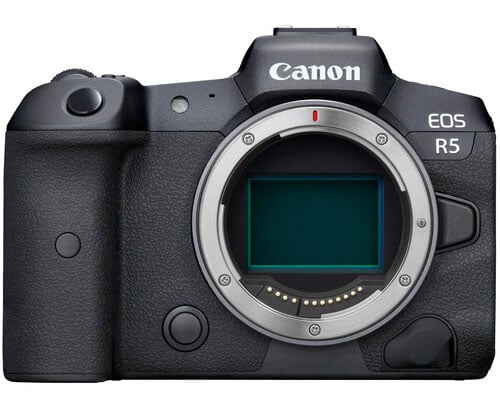
I’ve been shooting with the Canon EOS R5 for some time now, and it quickly became my go-to camera for landscape photography. With its 45MP sensor, I can capture every minute detail in a scene, whether it’s the delicate texture of leaves or the rugged lines of a mountain range. The dynamic range is phenomenal, allowing me to retain details in both the shadows and highlights during challenging lighting conditions—like a bright sky over a shadowed valley.
Get an inside look at the R5 in my 18-month long-term review above.
Specs:
- Sensor: 45MP full-frame CMOS sensor.
- ISO Range: 100-51,200 (expandable to 102,400).
- In-body Image Stabilization (IBIS): Yes, up to 8 stops.
- Weather Sealing: Fully weather-sealed body.
- Video: 8K at 30fps, 4K at 120fps.
- Burst Shooting: 20fps with electronic shutter, 12fps with mechanical.
Pros of the Canon EOS R5
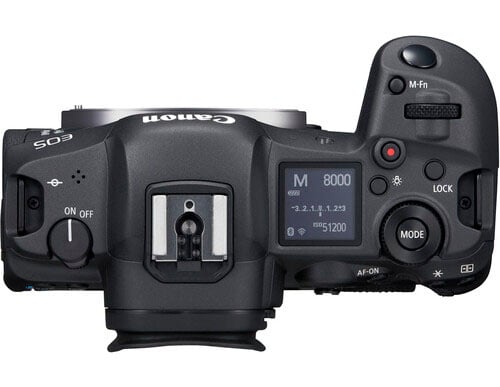
- Incredibly high resolution for capturing fine details in landscape shots.
- Excellent dynamic range, especially for challenging light conditions like sunsets and sunrises.
- 8-stop IBIS allows for handheld shots in low light or longer exposures.
- Weather-sealed for all types of outdoor conditions.
- Dual card slots for backup and security on long shoots.
One of the features I appreciate most is the 8-stop IBIS. This makes a world of difference when I’m out in the field and don’t want to lug around a tripod. I’ve been able to handhold shots at slower shutter speeds without worrying about camera shake, especially when I’m hiking through rough terrain. The R5 also holds up in tough conditions thanks to its weather sealing, which I’ve tested in everything from desert dust storms to misty mountain mornings.
Cons of the Canon EOS R5
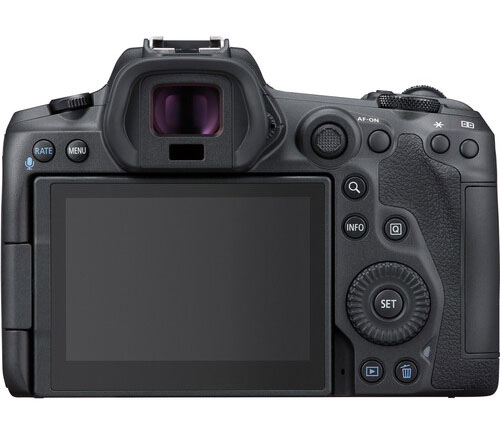
- Can overheat during extended 8K video recording.
- Higher price point, making it an investment for serious photographers.
Other than those two relatively minor issues, I honestly haven’t found any major flaws with this camera over the years. It’s simply a fantastic rig, especially for landscape photography.
In short, if you’re serious about landscape photography and need a camera that delivers across the board, the Canon EOS R5 is a powerhouse that doesn’t disappoint and feels amazing in your hands!
Best Canon Cameras for Landscape Photography: Canon EOS R6 Mark II
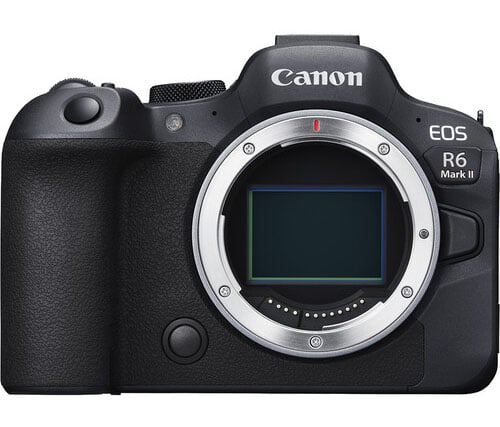
Having used both the original Canon EOS R6 and its successor, the R6 Mark II, I can confidently say the upgrade was worth it.
While the 24.2MP sensor may seem modest compared to the R5, it still produces stunningly detailed images, and the low-light performance is where this camera truly shines. Many of my favorite landscape shots are taken either at dawn or dusk, and the R6 Mark II handles these lighting conditions effortlessly. The ability to push the ISO without sacrificing image quality has been a game-changer for me as well.
Get a thorough walk-through of the Canon EOS R6 Mark II in my video above!
Specs:
- Sensor: 24.2MP full-frame CMOS sensor.
- ISO Range: 100-102,400 (expandable to 204,800).
- In-body Image Stabilization (IBIS): Yes, up to 8 stops.
- Weather Sealing: Yes.
- Video: 4K at 60fps.
- Burst Shooting: 40fps with electronic shutter, 12fps with mechanical.
Pros of the Canon EOS R6 Mark II
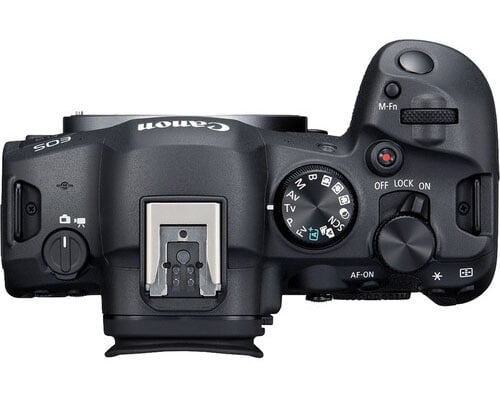
- Fantastic low-light performance, perfect for dawn and dusk landscapes.
- 8-stop IBIS for stabilized handheld shooting.
- Fast and accurate autofocus system, even in low-contrast situations.
- Compact body with professional ergonomics.
- Dual card slots for increased security when shooting.
One of the first things I noticed when I upgraded to the R6 Mark II was the improved autofocus system. It’s fast, responsive, and accurate, even in low-contrast situations like foggy mornings or shadowed forests. I also appreciate the ergonomics—the camera feels great in hand, with controls that are logically placed, making it comfortable to shoot with for extended periods. Canon’s attention to ergonomics is something I’ve always valued from the first time I picked up the original EOS R with the 15-35mm f/2.8, and the R6 Mark II is no exception.
Cons of the Canon EOS R6 Mark II
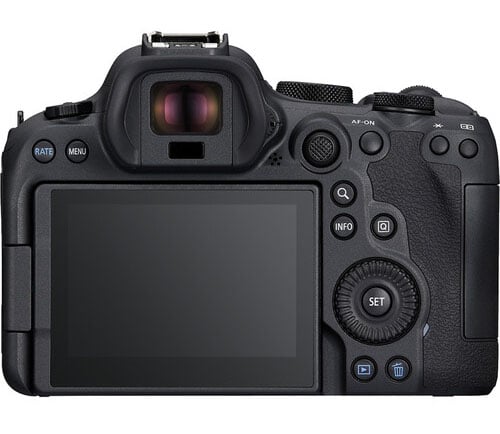
- Slightly lower resolution compared to the R5 (24.2MP).
- Limited video resolution compared to the R5 (no 8K).
But, again, these are nit-picky things. I’ve had the R6 Mark II for a while now, and I’ve yet to discover any major flaws with it. Yet another great option for your landscape photography!
Best Canon Cameras for Landscape Photography: Canon EOS R8
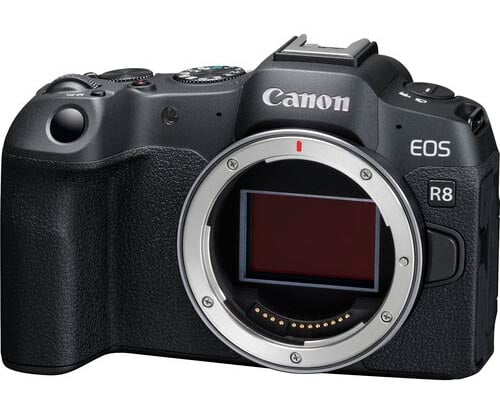
If you value portability without sacrificing image quality, the Canon EOS R8 is a fantastic option…
It’s a full-frame camera, but much more compact than the R5 or R6. Where the R5 and R6 may sting the old bank account, the R8 is a little more forgiving in this department. While I don’t own this camera and have only tested it, I can see this being a go-to when I know I’ll be covering long distances, hiking through rough terrain, or backpacking. Why, you may ask?
Well, to start, if you are watching the weight of what you are carrying, the R8 comes in roughly 7 ounces less than the R5 and R6. Yet, despite being smaller and lighter, the image quality is impressive, especially for the price point. The fast autofocus system makes it easy to capture quick compositions before the light changes or critters move, too.
Take a detailed look at the Canon EOS R8 in the video above by Simon d’Entremont.
Specs:
- Sensor: 24.2MP full-frame CMOS sensor.
- ISO Range: 100-102,400.
- In-body Image Stabilization (IBIS): No.
- Weather Sealing: No.
- Video: 4K at 60fps.
- Burst Shooting: 40fps with electronic shutter.
Pros of the Canon EOS R8
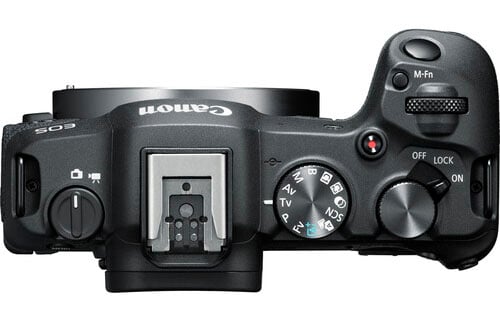
- Lightweight and compact, making it ideal for hiking and travel.
- Fast autofocus system, great for quick landscape compositions.
- Excellent image quality for its price point.
- 4K video capabilities for landscape filmmakers.
Keep Reading: What are the Best Cameras for Nature Photography?
Cons of the Canon EOS R8
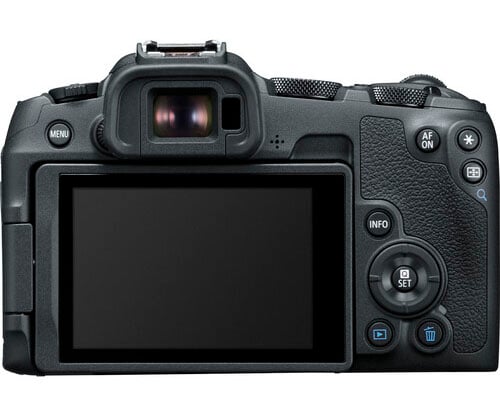
- No in-body image stabilization, which may require a tripod for longer exposures.
- Limited weather sealing, not ideal for extreme outdoor conditions.
The lack of in-body stabilization is definitely something to be mindful of. When shooting handheld, especially in lower light, I’ve noticed that I need to be more cautious with my shutter speeds.
That said, this really isn’t a big deal, considering that the lighting conditions for most of my work are usually awesome, and even still, I nearly always have my tripod with me. So if you’re like me and prefer to travel light, bring along a small, sturdy tripod (the Peak Design Travel Tripod is what I carry) to mitigate this limitation.
Best Canon Cameras for Landscape Photography: Canon EOS R10
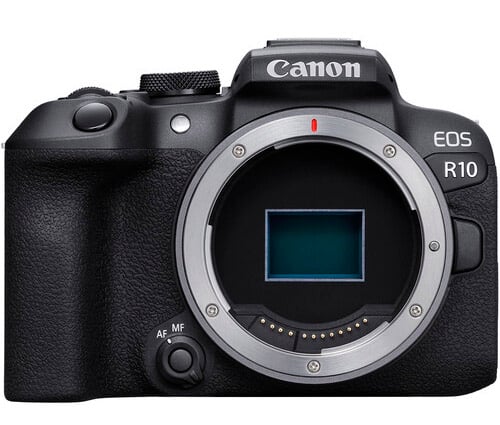
The Canon EOS R10 is a great option if you are just getting started or looking for a budget-friendly camera.
While it has an APS-C sensor, I’ve been pleasantly surprised by the image quality, especially when shooting in well-lit conditions. When I first got started, I shot with an APS-C sensor camera (Nikon D90) for some time before I made the jump to a full frame camera (Nikon D700). Even still, I kept my crop sensor camera for years after as a reliable second body.
Something that is a bit of a bonus on the R10, like what I mentioned a moment ago on the R8, is that this camera is also lightweight and portable coming in roughly one ounce lighter than the already lightweight R8. This makes the R10 a strong contender for travel photography. While it lacks some of the advanced features of the higher-end models, it’s still a capable performer for capturing beautiful landscapes.
Learn all about the Canon EOS R10 in the video above by Tech Through The Lens.
Specs:
- Sensor: 24.2MP APS-C CMOS sensor.
- ISO Range: 100-32,000.
- In-body Image Stabilization (IBIS): No.
- Weather Sealing: No.
- Video: 4K at 60fps.
- Burst Shooting: 23fps with electronic shutter, 15fps with mechanical.
Pros of the Canon EOS R10
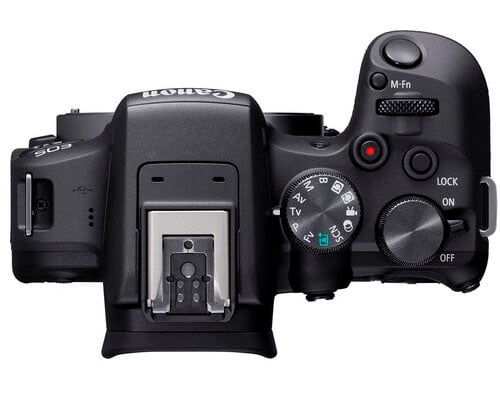
- Affordable and lightweight, perfect for beginners or those on a budget.
- Good image quality for an APS-C sensor, especially in well-lit conditions.
- Compact size makes it easy to carry on long hikes.
- 4K video capabilities for creative landscape filmmakers.
Cons of the Canon EOS R10
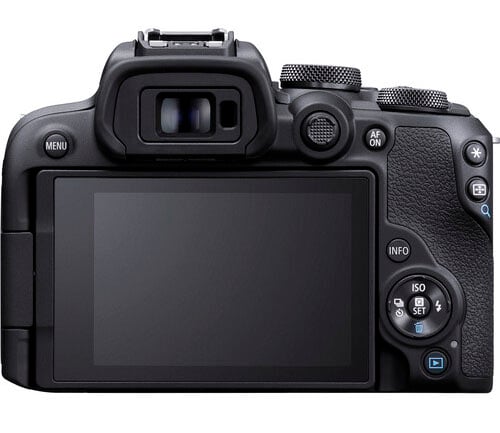
- No in-body stabilization or weather sealing.
- APS-C sensor doesn’t offer the same depth or dynamic range as full-frame.
One thing to keep in mind is that the APS-C sensor means you’re not getting the same depth and dynamic range as a full-frame camera. However, if you’re willing to work within its limits, the R10 is more than capable of producing excellent landscape shots. This camera is a workhorse and a fantastic option for anyone on a budget wanting to get into the Canon EOS R ecosystem.
Best Canon Cameras for Landscape Photography: Canon EOS 6D Mark II
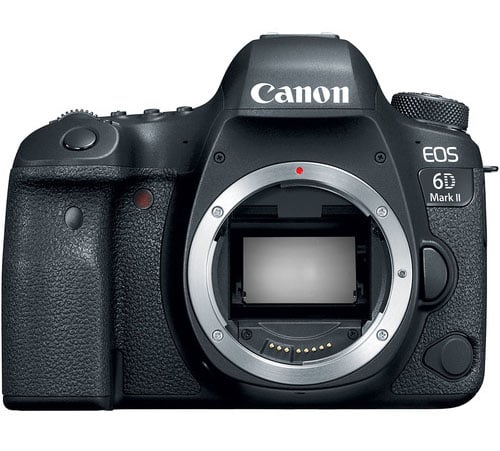
The Canon EOS 6D Mark II is a fantastic option if you’re a hobbyist landscape photographer looking for an affordable, full-frame camera.
Don’t get me wrong. While I appreciate the 26.2MP sensor, which delivers solid image quality, especially when working in well-lit conditions, what really excites me about this camera is the amazing affordability of its lenses.
You see, this camera uses Canon’s EF mount. Since many folks have jumped over to the R family of cameras, the used market is FULL of great deals on EF lenses (and older Canon camera bodies, for that matter). This means you can get into a full frame body with awesome specs for about the same price as the R10, which is a crop sensor.
While the EOS 6D Mark II doesn’t offer the ultra-high resolution of some of Canon’s newer models, it’s more than capable of producing detailed, vibrant landscape images.
Get some more insights into the Canon EOS 6D Mark II in the video above by
Jake Borowski.
Specs:
- Sensor: 26.2MP full-frame CMOS sensor.
- ISO Range: 100-40,000.
- In-body Image Stabilization (IBIS): No.
- Weather Sealing: Yes.
- Video: Full HD at 60fps.
- Burst Shooting: 6.5fps.
Pros of the Canon EOS 6D Mark II
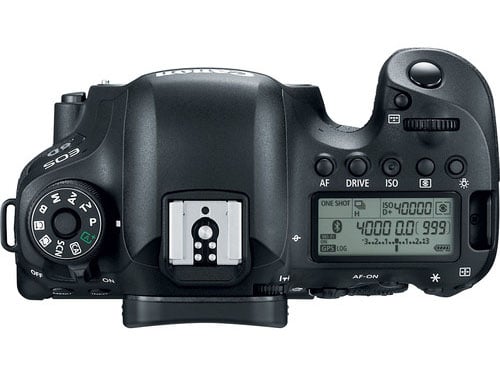
- Affordable full-frame camera, ideal for hobbyist landscape photographers.
- Good image quality, especially in well-lit conditions.
- Fully articulating touchscreen for versatile shooting angles.
- Weather-sealed body, great for outdoor photography.
- EF mount – very supply rich used market – means great deals!
One of my favorite features is the fully articulating touchscreen. This has been a huge help for shooting at unusual angles—whether I’m capturing low-to-the-ground perspectives of wildflowers or framing high-angle shots of mountain peaks.
The weather-sealed body has also proven to be a reliable companion when shooting in unpredictable conditions. I’ve used this camera in light rain and snow, and windy desert conditions without any issues.
Cons of the Canon EOS 6D Mark II
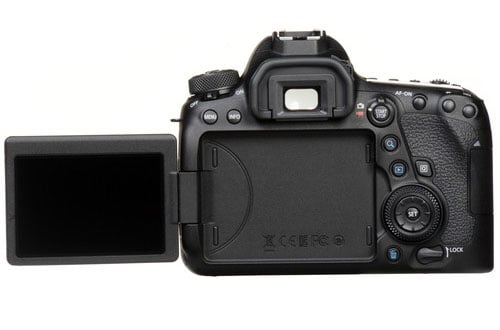
- Lacks in-body stabilization, requiring a tripod for longer exposures.
- Lower resolution compared to newer models.
One area where the 6D Mark II does fall short is the lack of in-body stabilization. This means I often rely on a tripod for longer exposures, especially when shooting at dawn or dusk, or when I’m working in less-than-ideal lighting conditions. But, as I mentioned earlier, this isn’t a big deal for me as I always have a tripod with me.
While the burst rate of 6.5fps is sufficient for most landscape needs, if you need fast burst rates, you might need to get creative here. That being said, the 6D Mark II has its rightful place on this list, especially if you are looking for a budget-friendly, full-frame camera that doesn’t compromise on image quality. It’s a solid, no-frills choice for anyone who wants to dive into landscape photography without breaking the bank.
Keep Reading: The Best DSLR Camera for Enthusiast Photographers
Final Thoughts on the Best Canon Cameras for Landscapes
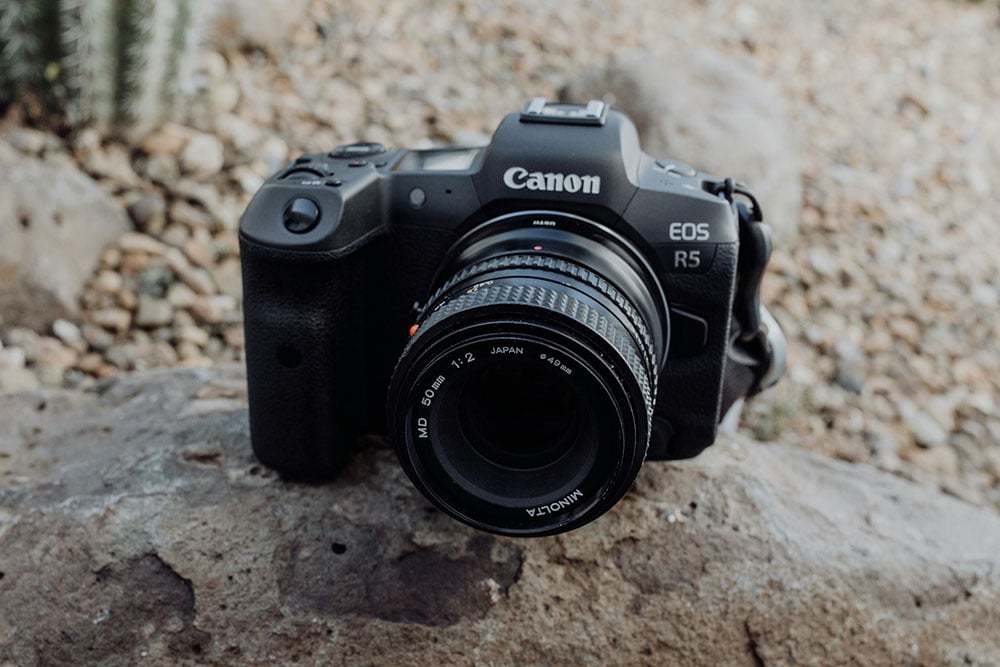
Photo by Josh Withers on Unsplash (license)
Closing things up on this Best Canon Cameras for Landscapes topic, for years, I’ve been saying the same thing—don’t get caught up in thinking you need the latest and greatest camera gear to take amazing photos.
The truth is, great shots are out there waiting for you, and it doesn’t really matter what camera you have in your hand (seriously, it doesn’t!). Whether it’s a film camera like this Canon AE-1 next to me, your iPhone that’s in your pocket, or any camera capable of capturing light and converting it into an image, it’s the photographer, not the gear, that makes the magic happen.
To the salty veterans out there reading this, you already know this truth all too well. But for those of you who are beginners, this reminder is aimed at you: focus on learning the fundamentals of photography—lighting, composition, exposure—and worry less about what camera you’re using. While this list includes some fantastic Canon cameras that will help you along your journey, remember that any camera can do the trick if you know how to use it.
This list represents a well-balanced selection of cameras, from high-end powerhouses like the EOS R5 to budget-friendly options like the EOS R10. Any one of them will do the job, but in the end, it’s your creativity and knowledge that will bring those landscapes to life!
Just so you know, some of the cool stuff we mention comes with affiliate links, meaning we earn a commission if you buy (no extra charge to you!). Plus, we occasionally feature sponsored content, but rest assured, we only shout out products we genuinely stand behind.
Learn More:
Hero photo by Photo by KAL VISUALS on Unsplash (license)


[…] Best Canon Cameras for Landscape Photography […]
[…] Best Canon Cameras for Landscape Photography […]
[…] Best Canon Cameras for Landscape Photography […]